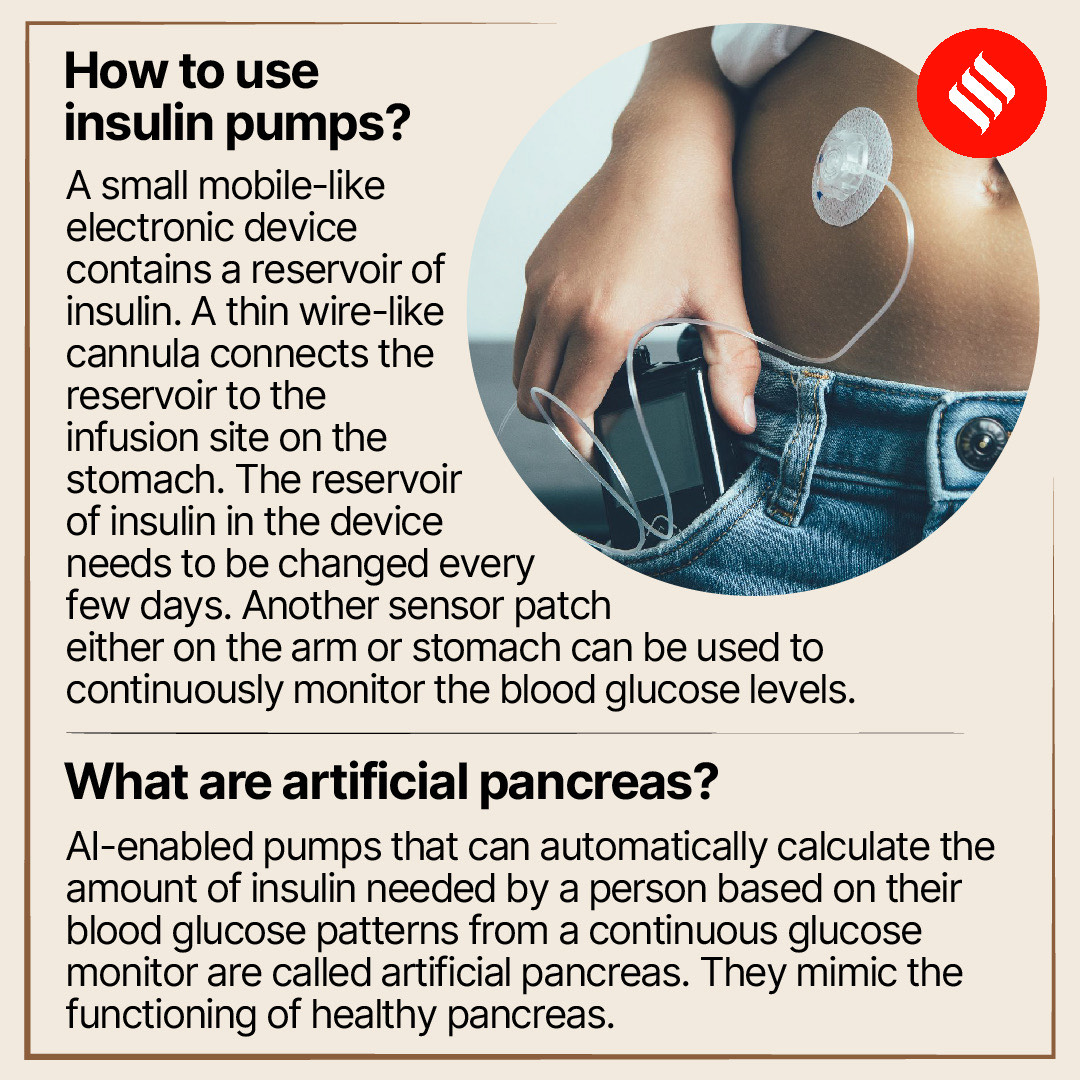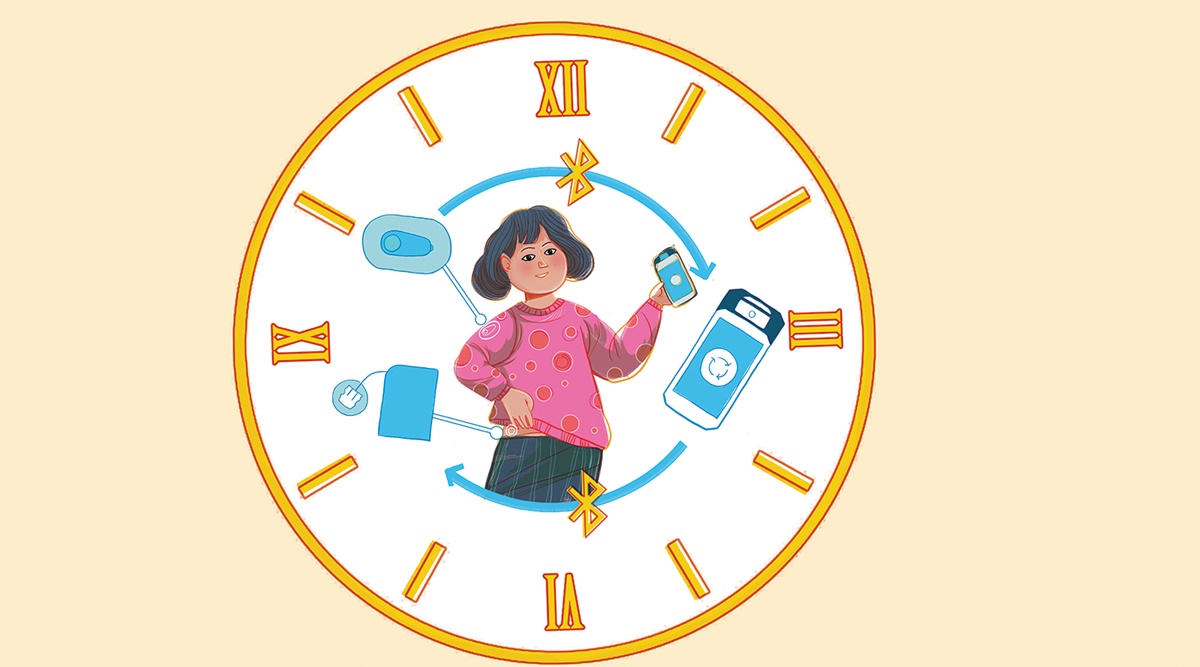Thirty-five-year-old Sakshi Gurtu likes to wear a slightly oversized T-shirt over her multi-pocket jeans. That’s because it helps her tuck in a little device called an insulin pump which delivers the hormone through a thin tube that goes under her skin. “It feels like a part of my body now,” says the Pune-based engineer, who has been living a normal life while managing her Type 1 diabetes for 17 years, a condition where the body loses the capability to secrete the insulin hormone responsible for maintaining blood glucose levels. “It is a lot about self-monitoring and measuring my life every moment. But this pump keeps me relaxed,” she adds as she goes out for her daily walk. With taboos around life-long use of insulin injectables, Sakshi has not only reclaimed her life but is now married to a work colleague.
How does this device help her and many like her? “It leads to better control of HbA1c (average blood glucose over three months) and can deliver insulin easily and accurately. Most importantly, its use provides more flexibility to meals, exercise and your daily schedules. It’s wearable and fuss-free,” says her treating doctor and uncle, Dr Subhash K Wangnoo, head of the Apollo Centre for Obesity, Diabetes, and Endocrinology (ACODE). At present, Sakshi has to calculate the amount of insulin she needs based on the readings from her continuous glucose monitor — a sensor placed just under the skin that can tell her about the ups and downs in her blood glucose levels through the day. She pushes a button, without pricking, to administer the insulin. Some of the latest insulin pumps are tubeless, and some can interact with the glucose data obtained from a continuous glucose monitor to adjust insulin doses automatically. She plans to switch to the newer AI-enabled one that integrates the pump with the continuous glucose monitor, allowing the machine to calculate the amount of insulin needed on its own. Insulin pumps are now being used as a convenient intervention by even those with severe manifestations of Type 2 diabetes (a lifestyle condition where the body might produce insulin but the cells become resistant to the hormone and is not enough to tackle the glucose levels).

For a long time, Sakshi was unaware of her condition till a Class XI assignment on diabetes alerted her to the possibility. “I was very lean, would frequently feel thirsty and rush to the washroom. Till then I thought that this was my normal bio-rhythm,” she says. Sakshi called her uncle. The diagnosis meant she would require insulin injections throughout her life. “It was because of my uncle that I chose diabetes as the subject of my school assignment. I thought I would research Type 2 diabetes because I could get real-life accounts from him. My grandfather was also living with it. I knew the signs and symptoms. I had lost a lot of weight without any loss in appetite. Initially, I thought it was because of the stress of examinations. But it continued even after my exams were over,” she says. She confided in her mother but both were uncertain about the onset of Type 2 diabetes in younger individuals. It was her brother who insisted on a test.
Post-diagnosis, Sakshi had to constantly watch her portions, eat meals at regular intervals and most importantly, take insulin shots before meals. She had to keep pricking her finger multiple times a day to test her blood glucose levels. Her insulin pump has been delivering small amounts of the hormone into the bloodstream at regular intervals, mimicking the process in healthy individuals. The device, akin to a pager that is always in her pocket, has given her the freedom to not look at her numbers all the time, be a little more flexible with her meals, and go out without worrying that her glucose levels might shoot up or drop suddenly.
The pump gave Sakshi the confidence to take up a job far away from home. Now, working in an IT company in the city, she doesn’t have to worry about taking her insulin in the middle of a presentation. However, she still keeps her portion sizes in mind and goes for a walk after her lunch. But what has held her in good stead is a positive attitude that has won her many friends. Even during her initial days in Pune, when she was still dependent on insulin shots, she had surrounded herself with an extremely supportive group of friends. “They would remind me religiously to take my shots before every meal. Their encouragement matters when you are staying away from your parents,” she says.
There is a dietary discipline which she has internalised, like staying away from sweets. “Since childhood, my brother and I have grown up eating healthy meals. Both of us do not have a sweet tooth. So, it was easy for me to cut out free sugars which result in sudden spikes in blood glucose levels,” says Sakshi, who keeps a steady watch over carbohydrates. “It’s not like I never had cakes, pizzas and burgers. But I would gratify rather than indulge myself. I would just have a bite of cake on someone’s birthday, take smaller portions of burger or a slice of pizza. On occasion, I have had alcohol too,” she says. She did everything a college student does with a few caveats — she had to take her shot before every meal, she had to control her portions and never skip a meal. She could not go to the gym, choosing yoga instead. “I realised that rigorous exercise in the gym led to sudden drop in my sugar levels, which can be more dangerous than a few spikes in the sugar levels,” adds Sakshi.
Dr Wangnoo, her treating doctor, says one of the biggest challenges for people living with Type 1 diabetes is access to devices like the ones his niece uses.The latest machine itself costs about Rs 8 lakh while the accessories add up to another Rs 8,000 to Rs 10,000. Older models can cost anywhere between Rs 2 to 5 lakh.
Most Read 1Chandrayaan-3 mission: Dawn breaks on Moon, all eyes on lander, rover to wake up 2As Indo-Canadian relations sour, anxiety grips Indian students, residents who wish to settle in Canada 3Karan Johar says Sanjay Leela Bhansali did not call him after Rocky Aur Rani: ‘He’s never called me but…’ 4Gadar 2 box office collection day 40: Hit by Shah Rukh Khan’s Jawan onslaught, Sunny Deol movie ends BO run with Rs 45 lakh earning 5Shubh’s tour in India cancelled: Why is the Canada-based singer facing the music?
He even says that red flags like significant weight loss despite normal appetite, unusual thirst and urinary bladder pressure are not enough for a diagnosis. “People need to get a blood sugar test along with an autoimmunity check that tracks five markers. Anybody with two or three positive markers is a definite case of Type 1 diabetes. Patients are often distraught that they have to take insulin for life. But the pump makes it easier,” he says.
While the most common age for Type 1 diabetes diagnosis is around 10 to 12 years, it can also be detected in children as early as one or two years old. But recently, there has been an alarming increase in the number of children being diagnosed with Type 2 diabetes, especially at the time of puberty. “Around 20 per cent of my early teenage patients come in with Type 2 diabetes, which needs to be managed with lifestyle changes and some pills rather than insulin shots,” he says.
Also ReadWeight loss is not just about cardio: Why you need strength training and …Why having leafy vegetables at the beginning of a meal can control your b…Is your bad cholesterol or LDL level not going down despite diet and exer…WHO hypertension report reveals 4.6 million lives in India can be saved b…
His niece’s diagnosis has also changed Dr Wangnoo’s perspective. “I treat all of my patients just like I would treat her. I understand the challenges that they are likely to face, listen to them carefully and then tell them that they shouldn’t be in denial about the diagnosis. Instead they should focus on practical ways to manage it. With controlled blood glucose levels, those with Type 1 diabetes can live as long and healthy a life as any other person,” he says. Meanwhile, Sakshi has proven her condition isn’t limiting and is looking to build a new life with her husband.
 (Designed by Angshuman Maity)
(Designed by Angshuman Maity)


